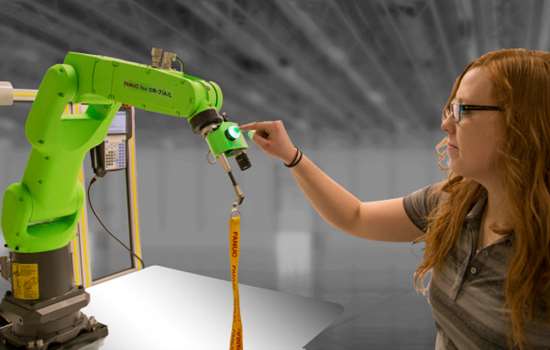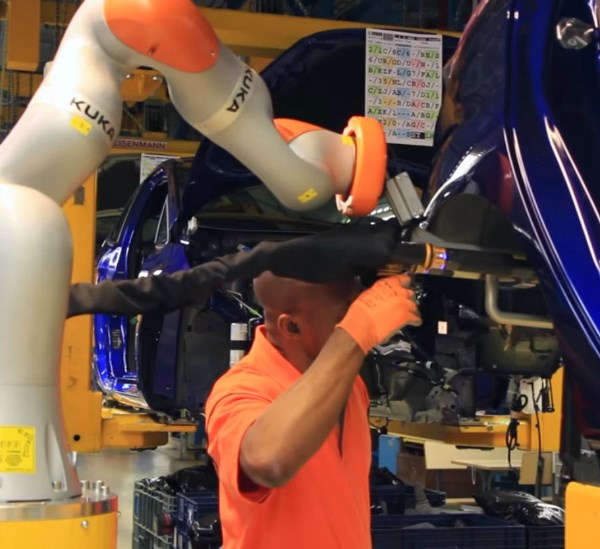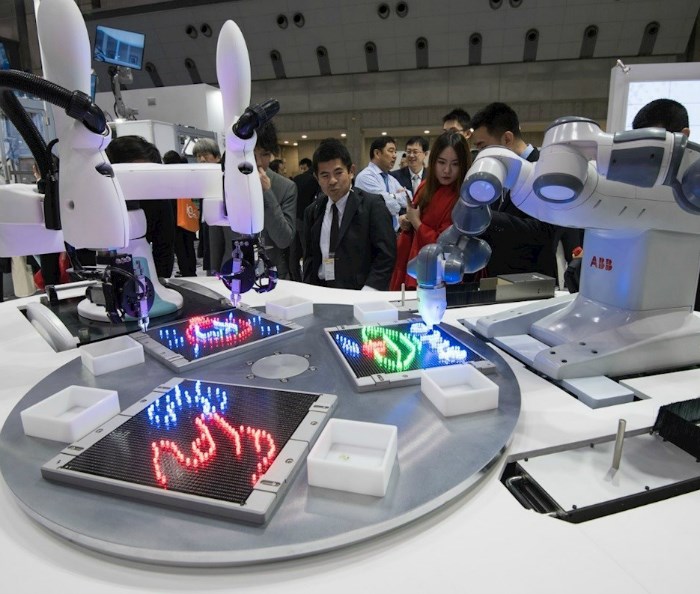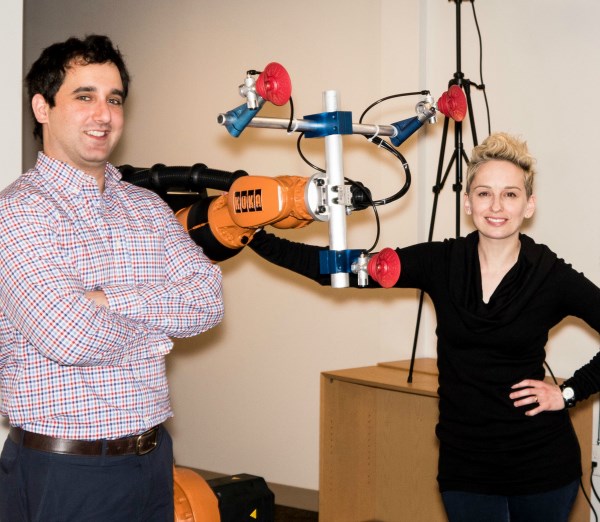Collaborative Robots: What You Should Know
The touch-sensitive, safety-minded devices occupy a growing niche as manufacturers find new, truly collaborative applications.
#robotics
The first industrial robot of any type was installed at a General Motors diecasting plant in Trenton, New Jersey, in 1959. It was a prototype, the Unimate #001. It became so successful in dealing with the hot metal that by 1961 some 450 Unimate robotic arms were employed in diecasting operations.
One thing worth noting about that original robot: it weighed 2,700 pounds. And from that point until recently, the potential dangers of automated arms meant that most industrial robots were cordoned off from human workers in order to protect the humans from the robots.
A huge change occurred in 2004 when KUKA Division Industries (kuka.com) released the first commercial “cobot.” That’s as in “collaborative robot.” Since then KUKA has been joined by a number of other manufacturers—including Universal Robots (universal-robots.com), ABB (new.abb.com/products/robotics), Kawasaki Heavy Industries (global.kawasaki.com), Yaskawa Motoman (motoman.com), and FANUC (fanucamerica.com)—in producing these automated devices that work directly with humans. That’s because, generically speaking, the cobot is distinguished by having a comparatively lightweight design, a less-rigid surface covering and, most importantly, sensors that allow it to detect and respond to unplanned contact by stopping almost instantly in its tracks.
This frees up space around the robot that otherwise would be inaccessible to human workers. A worker can safely do tasks alongside, and sometimes with, the robot.
According to KUKA Chief Regional Officer Joe Gemma, “In 2015 there were 2000 collaborative robots in use; by 2017, there were 8000.” And the International Federation of Robotics (ifr.org) has noted that while collaborative robots currently make up only about 3 percent of all robot sales across the globe, it expects that figure to jump to 34 percent by 2025.
Getting Better
Among the recent technology developments for cobots are more responsive sensors and more computing power in networked connections.
According to Michael Cicco, CEO of FANUC America, through the implementation of the ISO/TS 15066 safety standard, which was introduced in 2016, “We’ve been able to let the robots go faster, depending upon what the application is. When workers are nearby, the robot goes a little bit slower; if they leave, it can go faster.” Cicco explains that through sensors and software there is the ability to run a risk assessment and to adjust the cobot’s parameters accordingly.
Other improvements are in ease of use. The HC10 from Yaskawa Motoman is just one example of a cobot that can be taught by simply hand-guiding it through its required path and way points. This eliminates the complexity usually associated with robot programming, allowing an automation non-expert to nonetheless get the device deployed quickly. It can also be programmed the traditional way through the use of a teach pendant.
Also addressing ease-of-use concerns, collaborative robot makers ABB and Kawasaki Heavy Industries have themselves collaborated on a common interface for their cobots, featuring a simplified human–robot interface with intuitive, smartphone-like navigation and icons.
Whither the Cobot?
The IFR figures cited above—collaborative robots are expected to become 34 percent of robot sales by 2025—would seem to argue that the future of the collaborative robot is assured. But it’s possible that they may turn out to be a transitory innovation, to be made outmoded by a different kind of solution. It might be America Online before the coming of the Web.
Why? The range of the collaborative robot’s uses is constrained by its designed-in physical limitations in strength and speed. It’s made not only to stop what it’s doing before it strikes a person but also for such a strike to be of negligible power in any case. So, while manufacturers have been finding them beneficial in certain applications, they represent a small part of the entire range of useful automation. Faster, stronger robots—fenced off—would seem to still be a necessary solution for many automation tasks.
And so the hunt is on for a third solution (after fences and cobots), which could enable human collaboration with those robots of greater power that are currently behind fences.
“Even now, some traditional robots are being put in collaborative environments, enabled by superior sensor technology to recognize that there’s some change in condition, and to respond appropriately,” KUKA CRO Joe Gemma says.
“Sensor technology has advanced so rapidly in the last couple of years that they’re enabling use in very different manufacturing environments. In fact, companies such as VEO Robotics are working on sensor technology that will recognize not only the robot and any violation of its space, but also the tooling and whatever the robot’s carrying. That’s the next big leap,” Gemma says.
The VEO Robotics (veobot.com) system implements depth-sensing cameras and 3D sensors to monitor the entire work area around a robot, using powerful parallel computing controlled by software that lets the robot learn to differentiate between the objects around it—giving it spatial awareness of everything there. And when something shows up that isn’t supposed to be there, such as a human worker, the robot will stop what it’s doing.
The goal of the VEO system is for it to work with robots of any size and functionality. The vision system, computing power and software is made to integrate with the existing robot system. (Though company photos show the system in use with a KUKA robot, the idea is for the system to be “robot-agnostic.”) The VEO system completely foregoes the usual collaborative-robot approach of making a robot that’s less dangerous if an accident occurs, and instead is all in on ensuring such an accident never happens. The company is currently testing prototypes with manufacturing partners and expects to be ready for the marketplace in 2019. If it succeeds, the term “collaborative robot” will have to stretch to encompass all industrial robots.
RELATED CONTENT
-
On Automotive: An All Electric Edition
A look at electric vehicle-related developments, from new products to recycling old batteries.
-
Choosing the Right Fasteners for Automotive
PennEngineering makes hundreds of different fasteners for the automotive industry with standard and custom products as well as automated assembly solutions. Discover how they’re used and how to select the right one. (Sponsored Content)
-
Jeeps Modified for Moab
On Easter morning in Moab, Utah, when the population of that exceedingly-hard-to-get-to town in one of the most beautiful settings on Earth has more than doubled, some people won’t be hunting for Easter eggs, but will be trying to get a good look at one of the vehicles six that Jeep has prepared for real-life, fast-feedback from the assembled at the annual Easter Jeep Safari.













